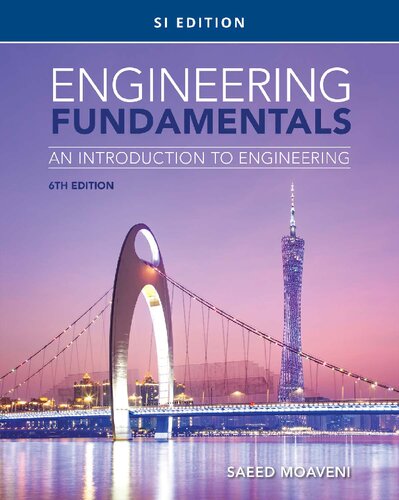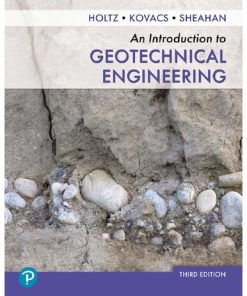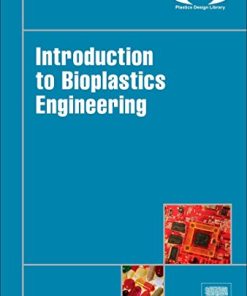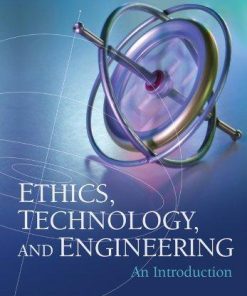(Ebook PDF) Engineering Fundamentals An Introduction to Engineering 6th Edition by Saeed Moaveni 9798214352640 full chapters
$50.00 Original price was: $50.00.$25.00Current price is: $25.00.
Engineering Fundamentals: An Introduction to Engineering 6th Edition by Saeed Moaveni – Ebook PDF Instant Download/DeliveryISBN: 9798214352640
Full download Engineering Fundamentals: An Introduction to Engineering 6th Edition after payment.

Product details:
ISBN-13 : 9798214352640
Author: Saeed Moaveni
Discover what it takes to be a successful engineer today with Moaveni’s ENGINEERING FUNDAMENTALS: AN INTRODUCTION TO ENGINEERING, SI Edition 6th Edition. This reader-friendly approach helps you develop the strong problem-solving skills and solid foundation in fundamental principles you need to become an analytical, detail-oriented and creative engineer. This edition opens with an overview of what engineers do and includes behind-the-scenes glimpses inside areas of specialization. Candid, straight-forward discussions examine what you need to succeed as an engineer today. You study basic physical concepts and laws that are important in your engineering studies as well as on the job. In addition, Professional Profiles throughout this edition highlight the work of practicing engineers around the globe and connect the fundamental principles you’re learning to professional engineering success.
Engineering Fundamentals: An Introduction to Engineering 6th Table of contents:
Part 1. Engineering
Chapter 1. Introduction to the Engineering Profession
1.1. Engineering Work Is All Around You
Engineers Deal with an Increasing World Population and Sustainability Concerns
1.2. Engineering as a Profession
What Is Engineering and What Do Engineers Do?
1.3. Common Traits of Good Engineers
1.4. Engineering Disciplines
What Are Some Areas of Engineering Specialization?
Accreditation Board for Engineering and Technology
Professional Engineer
Engineering Technology
Summary
Key Terms
Problems
Chapter 2. Preparing for an Engineering Career
2.1. Making the Transition from High School to College
2.2. Budgeting Your Time
2.3. Study Habits and Strategies
Attend Your Classes Regularly
2.4. Getting Involved with an Engineering Organization
2.5. Your Graduation Plan
Other Considerations
Summary
Key Terms
Chapter 3. Introduction to Engineering Design
3.1. Engineering Design Process
Step 1: Recognizing the Need for a Product or a Service
Step 2: Problem Definition and Understanding
Step 3: Research and Preparation
Step 4: Conceptualization
Step 5: Synthesis
Step 6: Evaluation
Step 7: Optimization
Step 8: Presentation
Civil Engineering Design Process
3.2. Additional Design Considerations
Sustainability in Design
The Earth Charter
Key Sustainability Assessment: Life-Cycle Analysis
Engineering Economics
Material Selection
Patent, Trademark, and Copyright
3.3. Teamwork
Common Traits of Good Teams
Conflict Resolution
3.4. Project Scheduling and the Task Chart
3.5. Engineering Standards and Codes
Why Do We Need Standards and Codes?
Examples of Standards and Codes Organizations in the United States
Examples of International Standards and Codes
3.6. Water and Air Standards in the United States
Drinking Water
Outdoor Air
Indoor Air
Methods to Manage Contaminants
Summary
Key Terms
Problems
Chapter 4. Engineering Communication
4.1. Communication Skills and Presentation of Engineering Work
4.2. Basic Steps Involved in the Solution of Engineering Problems
Step 1: Defining the Problem
Step 2: Simplifying the Problem
Step 3: Performing the Solution or Analysis
Step 4: Verifying the Results
Homework Presentation
4.3. Written Communication
Progress Report
Executive Summary
Short Memos
Detailed Technical Report
4.4. Oral Communication
4.5. Graphical Communication
Summary
Key Terms
Problems
Chapter 5. Engineering Ethics
5.1. Engineering Ethics
5.2. The Code of Ethics of the National Society of Professional Engineers
Code of Ethics for Engineers
5.3. Engineer’s Creed
5.4. Academic Dishonesty, Conflict of Interest, Professional Responsibility
2012 Milton F. Lunch Ethics Contest
2013 Milton F. Lunch Ethics Contest
Confidentiality of Engineering Report: Case No. 82-2
Gift Sharing of Hotel Suite: Case No. 87-4
Credit for Engineering Work-Design Competition: Case No. 92-1
Services—Same Services for Different Clients: Case No. 00-3
Use of Alleged Hazardous Material in a Processing Facility: Case No. 99-11
Software Design Testing: Case No. 96-4
Whistleblowing: Case No. 82-5
Academic Qualifications: Case No. 79-5
Advertising–Misstating Credentials: Case No. 92-2
Advertising–Statement of Project Success: Case No. 79-6
Using Technical Proposal of Another Without Consent: Case No. 83-3
Use of CD-ROM for Highway Design: Case No. 98-3
Summary
Key Terms
Problems
Appendix 5A
Part 2. Engineering Fundamentals
Chapter 6. Fundamental Dimensions and Systems of Units
6.1. Fundamental Dimensions and Units
6.2. Systems of Units
International System (SI) of Units
British Gravitational System of Units
U.S. Customary System of Units
6.3. Unit Conversion and Dimensional Homogeneity
Unit Conversion
Dimensional Homogeneity
Numerical versus Symbolic Solutions
6.4. Significant Digits (Figures)
Addition and Subtraction Rules
6.5. Components and Systems
6.6. Physical Laws and Observations
Learning Engineering Fundamental Concepts and Design Variables from Fundamental Dimensions
Summary
Key Terms
Problems
Chapter 7. Length and Length-Related Variables in Engineering
7.1. Length as a Fundamental Dimension
Measurement and Calculation of Length
Nominal Sizes versus Actual Sizes
7.2. Ratio of Two Lengths—Radians and Strain
Radians as a Ratio of Two Lengths
Strain as a Ratio of Two Lengths
7.3. Area
Area Calculations and Measurement
Approximation of Planar Areas
7.4. Volume
Volume Calculations
7.5. Second Moment of Area
Summary
Key Terms
Problems
Chapter 8. Time and Time-Related Variables in Engineering
8.1. Time as a Fundamental Dimension
8.2. Measurement of Time
The Need for Time Zones
Daylight Saving Time
8.3. Periods and Frequencies
8.4. Flow of Traffic
8.5. Engineering Variables Involving Length and Time
Linear Velocities
Linear Accelerations
Volume Flow Rate
Angular Motion
Summary
Key Terms
Problems
Chapter 9. Mass and Mass-Related Variables in Engineering
9.1. Mass as a Fundamental Dimension
Measurement of Mass
9.2. Density, Specific Weight, Specific Gravity, and Specific Volume
9.3. Mass Flow Rate
9.4. Mass Moment of Inertia
Disk
9.5. Momentum
Kinetic Energy
9.6. Conservation of Mass
Summary
Key Terms
Problems
Chapter 10. Force and Force-Related Variables in Engineering
10.1. Force
Tendencies of a Force
Units of Force
Spring Forces and Hooke’s Law
Friction Forces—Dry Friction and Viscous Friction
10.2. Newton’s Laws in Mechanics
What We Mean by Mechanics
Newton’s First Law
Newton’s Second Law
Newton’s Third Law
Newton’s Law of Gravitation
10.3. Moment, Torque—Force Acting at a Distance
External Force, Internal Force, Reaction Force
Boundary and Initial Conditions
10.4. Work—Force Acting Over a Distance
10.5. Pressure and Stress—Force Acting Over an Area
Common Units of Pressure
Pascal’s Law
Atmospheric Pressure
Absolute Pressure and Gauge Pressure
Vapor Pressure of a Liquid
Hydraulic Systems
Stress
Modulus of Elasticity, Modulus of Rigidity, and Bulk Modulus of Compressibility
Bulk Modulus of Compressibility
10.6. Linear Impulse—Force Acting Over Time
Summary
Key Terms
Problems
Chapter 11. Temperature and Temperature-Related Variables in Engineering
11.1. Temperature as a Fundamental Dimension
Measurement of Temperature and Its Units
Absolute Zero Temperature
11.2. Temperature Difference and Heat Transfer
Conduction
Thermal Resistance
Convection
Radiation
11.3. Thermal Comfort
11.4. Heating Values of Fuels
11.5. Degree Days and Energy Estimation
11.6. Additional Temperature-Related Material Properties
Thermal Expansion
Specific Heat
Summary
Key Terms
Problems
Chapter 12. Electric Current and Related Variables in Engineering
12.1. Electric Current, Voltage, and Electric Power
Electric Current as a Fundamental Dimension
Voltage
Direct Current and Alternating Current
Kirchhoff’s Current Law
12.2. Electrical Circuits and Components
Ohm’s Law
The American Wire Gauge (AWG)
Electric Power
Series Circuit
Parallel Circuit
Capacitors
12.3. Electric Power Sources
Batteries
Residential Power Distribution
12.4. Electric Motors
Motor Type
Duty Cycle
12.5. Lighting Systems
Lighting System Audit
Summary
Key Terms
Problems
Chapter 13. Energy and Power
13.1. Work, Mechanical Energy, and Thermal Energy
Kinetic Energy
Potential Energy
Elastic Energy
Thermal Energy
13.2. Conservation of Energy
Conservation of Mechanical Energy
First Law of Thermodynamics
13.3. Power
Watts and Horsepower
13.4. Efficiency
Power Plant Efficiency
Internal Combustion Engine Efficiency
Motor and Pump Efficiency
Efficiency of Heating, Cooling, and Refrigeration Systems
13.5. Energy Sources, Generation, and Consumption
Coal
Natural Gas
Heating Oil
Nuclear Energy
Hydro-Energy
Impoundment
Diversion
Pumped Storage Hydropower
Solar Energy
Solar Systems
Passive Solar Systems
Photovoltaic Systems
Wind Energy
Biomass
Wood
Algae
Ethanol
Summary
Key Terms
Problems
Part 3. Computational Engineering Tools
Chapter 14. Computational Engineering Tools Electronic Spreadsheets
14.1. Microsoft Excel Basics
Naming Worksheets
Cells and Their Addresses
A Range
Inserting Cells, Columns, and Rows
Creating Formulas in Excel
Absolute Cell Reference, Relative Cell Reference, and Mixed Cell Reference
14.2. Excel Functions
The Now and Today Functions
Using Excel Logical Functions
14.3. Plotting with Excel
Plotting Two Sets of Data with Different Ranges on the Same Chart
Curve Fitting with Excel
14.4. Matrix Computation with Excel
Matrix Algebra
14.5. An Introduction to Excel’s Visual Basic for Applications
A Simple VBA Code
Using Excel Functions in VBA
Learning by Recording Macros
VBA’S Object-Oriented Syntax
An Example of a for Loop
A Custom-Made Dialog Box
Summary
Key Terms
Problems
Chapter 15. Computational Engineering Tools MATLAB
15.1. MATLAB Basics
The format , disp , and fprintf Commands
Saving Your MATLAB Workspace
Generating a Range of Values
Creating Formulas in MATLAB
Element-by-Element Operation
Matrix Operations
15.2. MATLAB Functions, Loop Control, and Conditional Statements
Loop Control—The for and while Commands
Using MATLAB Logical and Relational Operators
The Conditional Statements—if, else
The M-File
15.3. Plotting with MATLAB
Importing Excel and Other Data Files into MATLAB
15.4. Matrix Computations with MATLAB
Curve Fitting with MATLAB
15.5. Symbolic Mathematics with MATLAB
Solutions of Simultaneous Linear Equations
Summary
Key Terms
Problems
Part 4. Engineering Graphical Communication
Chapter 16. Engineering Drawings and Symbols
16.1. Mechanical Drawings
Orthographic Views
Dimensioning and Tolerancing
Isometric View
Sectional Views
16.2. Civil, Electrical, and Electronic Drawings
16.3. Solid Modeling
16.4. Engineering Symbols
Examples of Common Symbols in Civil, Electrical, and Mechanical Engineering
Summary
Key Terms
Problems
Part 5. Engineering Material Selection
Chapter 17. Engineering Materials
17.1. Material Selection and Origin
Earth—Our Home
17.2. The Properties of Materials
Electrical Resistivity
17.3. Metals
Lightweight Metals
Copper and Its Alloys
Iron and Steel
17.4. Concrete
17.5. Wood, Plastics, Silicon, Glass, and Composites
Wood
Plastics
Silicon
Glass
Composites
17.6. Fluid Materials: Air and Water
Air
Water
Summary
Key Terms
Problems
Part 6. Mathematics, Statistics, and Engineering Economics
Chapter 18. Mathematics in Engineering
18.1. Mathematical Symbols and Greek Alphabet
The Greek Alphabet and Roman Numerals
18.2. Linear Models
A Linear Spring
Linear Equations and Slopes
Linear Interpolation
Systems of Linear Equations
18.3. Nonlinear Models
Polynomial Functions
18.4. Exponential and Logarithmic Models
The Cooling of Steel Plates
Logarithmic Functions
18.5. Matrix Algebra
Basic Definitions
Matrix Addition or Subtraction
Matrix Multiplication
Transpose of a Matrix
Determinant of a Matrix
Solutions of Simultaneous Linear Equations
Inverse of a Matrix
18.6. Calculus
Differential Calculus
Integral Calculus
18.7. Differential Equations
Summary
Key Terms
Problems
Chapter 19. Probability and Statistics in Engineering
19.1. Probability—Basic Ideas
19.2. Statistics—Basic Ideas
19.3. Frequency Distributions
Cumulative Frequency
19.4. Measures of Central Tendency and Variation—Mean, Median, and Standard Deviation
19.5. Normal Distribution
Summary
Key Terms
Problems
Chapter 20. Engineering Economics
20.1. Cash Flow Diagrams
20.2. Simple and Compound Interest
Compound Interest
20.3. Future Worth of a Present Amount and Present Worth of a Future Amount
Present Worth of a Future Amount
20.4. Effective Interest Rate
20.5. Present and Future Worth of Series Payment
Future Worth of Series Payment
20.6. Interest–Time Factors
20.7. Choosing the Best Alternatives—Decision Making
Present Worth or Present Cost Analysis
20.8. Excel Financial Functions
People also search for Engineering Fundamentals: An Introduction to Engineering 6th:
software engineering fundamentals
electrical engineering fundamentals
data engineering fundamentals
electrical engineering fundamentals 2e
mechanical engineering fundamentals
Tags:
Engineering Fundamentals,Introduction,Engineering,Saeed Moaveni
You may also like…
Engineering - Civil & Structural Engineering
An Introduction to Geotechnical Engineering 3rd Edition Robert D. Holtz
Engineering - Mechanical Engineering & Dynamics
Computers - Programming
Engineering - Engineering - General & Miscellaneous
Engineering Fundamentals: An Introduction to Engineering, 6th Edition Moaveni Saeed
Engineering - Chemical Engineering Technique - Electronics
Technique - Energy: Renewable Energy












